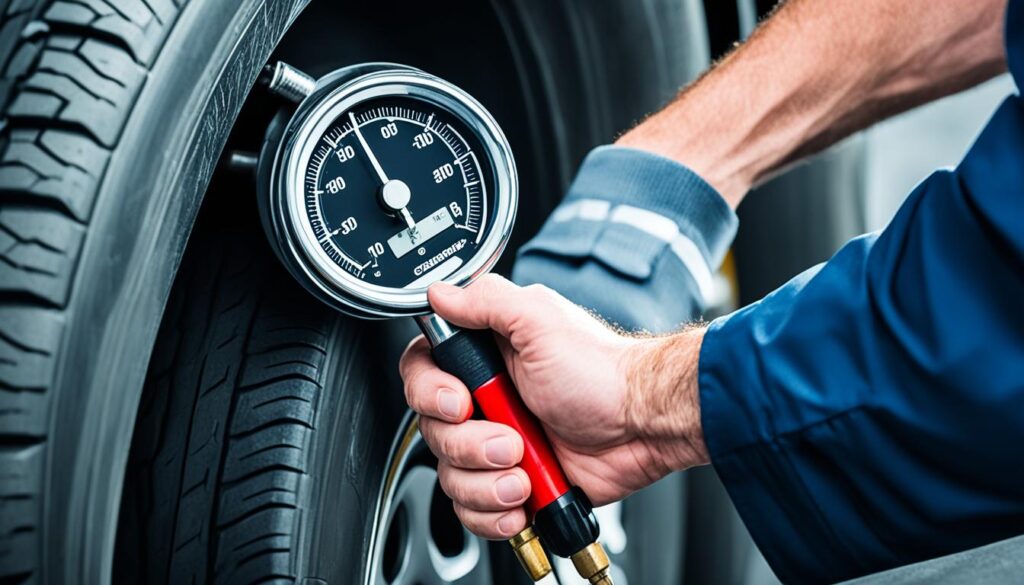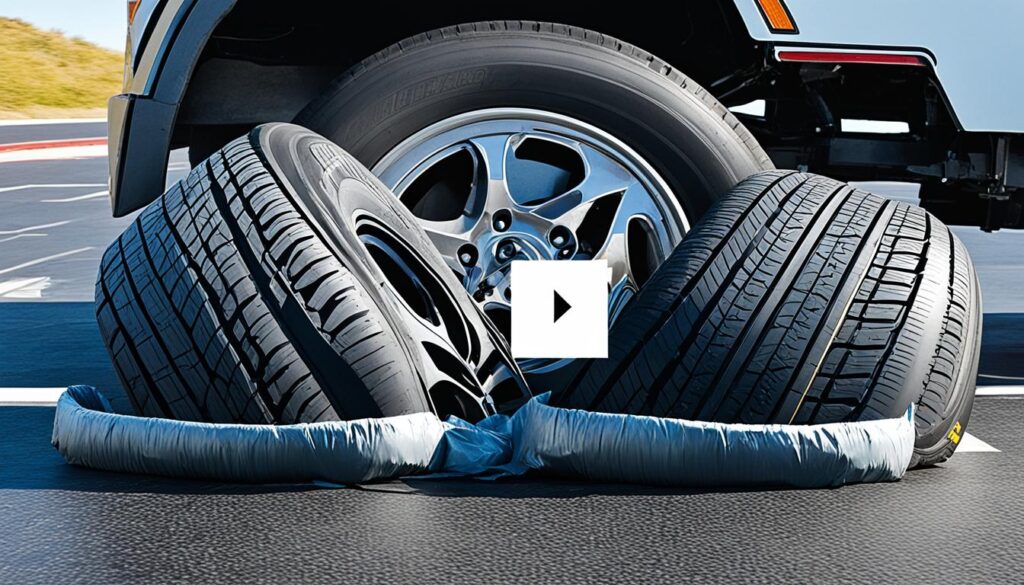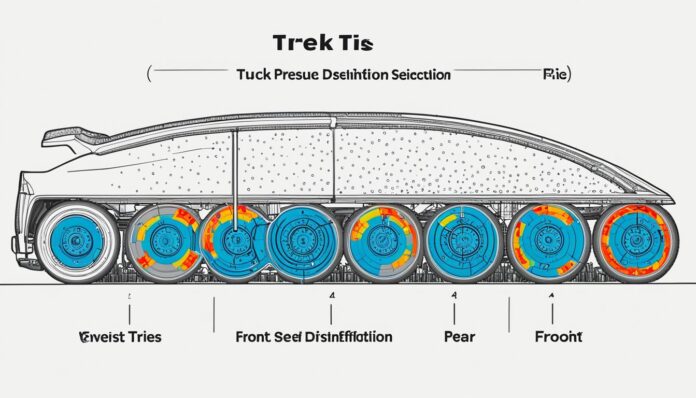As an Amazon Associate, I earn from qualifying purchases
When it comes to truck tire pressure, there is an ongoing debate about whether it should be higher in the front or rear tires. Some argue that higher pressure in the front is essential due to weight distribution, while others believe that higher pressure in the rear ensures better handling and wear. Finding the optimal tire pressure for your truck depends on various factors, including the type of truck, load distribution, and manufacturer’s recommendations. Let’s explore the considerations for truck tire pressure distribution in more detail.
Key Takeaways:
- Optimal truck tire pressure can vary between the front and rear tires.
- Finding the right tire pressure depends on factors like weight distribution and manufacturer’s recommendations.
- Imbalanced tire pressure can affect handling, stability, wear, and fuel efficiency.
- Regular monitoring and adjustment of tire pressure are crucial for optimal performance and safety.
- Using a tire pressure monitoring system can provide real-time information and help maintain proper tire pressure.
Factors Affecting Truck Tire Pressure
When optimizing truck tire pressure, it is essential to consider several factors that can influence performance and safety. These factors include:
- Weight Distribution: The balance between the front and rear axles plays a crucial role in tire pressure optimization. An imbalance in tire pressure can lead to uneven wear, poor handling, and reduced fuel efficiency. It is important to distribute the weight evenly to maintain optimal tire pressure and ensure even tread wear.
- Type of Load: Different loads require varying tire pressures. Lighter loads may require lower tire pressure to provide better traction, while heavier loads generally necessitate higher pressure to support the additional weight.
- Tire Manufacturer’s Recommendations: Each tire manufacturer provides specific recommendations for tire pressure based on the tire’s design and intended use. Following these guidelines ensures optimal performance and safety.
- Tire Pressure Monitoring Systems: Modern trucks are equipped with advanced tire pressure monitoring systems that provide real-time information about tire pressure. These systems help detect tire pressure imbalances and notify the driver of any deviations from the recommended levels.
A proper understanding of these factors and their impact on tire pressure is crucial for optimizing truck performance and maximizing tire longevity. Regular monitoring of tire pressure can help prevent issues caused by imbalances and ensure a smooth and safe journey.
Example Table: Factors Affecting Truck Tire Pressure
| Factors | Impact on Tire Pressure |
|---|---|
| Weight Distribution | Uneven tread wear, poor handling, decreased fuel efficiency |
| Type of Load | Different loads require varying tire pressures for optimal traction and stability |
| Tire Manufacturer’s Recommendations | Following manufacturer guidelines ensures optimal performance and safety |
| Tire Pressure Monitoring Systems | Real-time monitoring detects imbalances and alerts the driver to deviations from recommended levels |
Understanding these factors empowers truck owners to fine-tune tire pressure for better performance, safety, and efficiency.
Front vs Rear Tire Pressure Recommendations
When it comes to maintaining the optimal tire pressure for heavy-duty trucks, understanding the recommendations for front and rear tires is crucial. The tire pressure requirements can vary depending on the type of truck and its load capacity. Let’s explore some key considerations and recommendations for tire pressure adjustment to ensure optimal performance and safety.
In certain cases, the front and rear tires may require equal pressure to maintain a balanced load distribution. This is especially true for trucks with a symmetrical weight distribution and no significant difference in load between the front and rear axles. It is important to consult the manufacturer’s recommendations for specific tire pressure values and adjust accordingly.
However, in many cases, the rear tires may require higher pressure due to the additional weight they carry. This is particularly common in heavy-duty trucks that carry heavy loads or have equipment installed at the rear. By increasing the tire pressure in the rear, truck owners can ensure adequate support and minimize the risk of tire damage or failure.
Regular maintenance and adjustment of tire pressure are essential for heavy-duty truck tire management. By following the manufacturer’s recommendations, truck owners can optimize the tire performance and enhance overall safety on the road. It is recommended to check and adjust the tire pressure during routine maintenance checks or before embarking on long journeys.
Now, let’s take a look at a comparison table summarizing the tire pressure recommendations for front and rear truck tires:
| Tire Position | Tire Pressure |
|---|---|
| Front | Recommended pressure according to manufacturer guidelines |
| Rear | Higher pressure, considering additional weight and load capacity |
Following these tire pressure recommendations and regularly monitoring and adjusting the pressure can significantly improve heavy-duty truck tire maintenance. It is an essential aspect of ensuring optimal performance, handling, and safety for both the driver and the cargo being transported.
References:
- “Maintaining Proper Tire Pressure.” Trucking Info. Accessed September 29, 2022. https://www.truckinginfo.com/345961/maintaining-proper-tire-pressure.
- “Tire Pressure and Heavy-Duty Trucks.” Fleet Owner. Accessed September 29, 2022. https://www.fleetowner.com/blog/tire-pressure-and-heavy-duty-trucks.

Tire Pressure and Handling
Proper tire pressure plays a significant role in the handling and stability of a truck. Imbalanced tire pressure between front and rear tires can lead to handling issues such as understeer or oversteer. Understeer occurs when a truck tends to turn less sharply than intended, while oversteer occurs when the rear tires lose traction and the truck spins out. By maintaining the recommended tire pressure and ensuring proper weight distribution, truck owners can optimize handling and reduce the risk of accidents.
When tire pressure is imbalanced, the truck’s performance and safety may be compromised. A tire pressure imbalance can cause uneven weight distribution, affecting the grip of the tires on the road. This, in turn, impacts the truck’s ability to maintain traction and maneuver effectively in various driving conditions.
Understeer, also known as “push” or “plow,” is a common handling issue associated with low front tire pressure or high rear tire pressure. When there is an imbalance between front and rear tire pressure, the truck’s front tires may not have enough grip to maintain control during turns. As a result, the truck tends to resist turning, requiring more effort from the driver to steer and potentially leading to an increased risk of accidents.
Conversely, oversteer can occur when there is excessive rear tire pressure or low front tire pressure. In this scenario, the rear tires lose traction, causing the rear end of the truck to swing out in a potentially uncontrollable manner. Oversteer can make the truck spin out or fishtail, posing a serious hazard to the driver and other vehicles on the road.
By properly distributing tire pressure and ensuring the recommended levels are maintained, truck owners can enhance overall handling and stability. It is crucial to regularly check and adjust tire pressure according to manufacturer recommendations and consider factors such as load distribution and driving conditions.
Tire Pressure Distribution and Weight Distribution
When discussing tire pressure and handling, it is essential to emphasize the relationship between tire pressure distribution and weight distribution. Proper weight distribution across the axles of a truck contributes to optimal handling and stability.
An unbalanced weight distribution can exacerbate the handling issues associated with tire pressure imbalances. For example, if the front tires of a truck are carrying more weight than the rear tires, there is a higher risk of understeer. Conversely, if the rear tires are overloaded, the risk of oversteer increases.
It is worth noting that weight distribution can vary depending on factors such as cargo, load configuration, and truck design. Truck owners should refer to manufacturers’ guidelines for weight distribution and adjust tire pressure accordingly to maintain stability and reduce the likelihood of handling problems.
The Importance of Regular Tire Pressure Checks
Truck owners must prioritize regular tire pressure checks to ensure optimal handling and safety. Monitoring tire pressure and addressing any imbalances promptly can prevent accidents caused by poor handling and instability.
Modern trucks are often equipped with tire pressure monitoring systems (TPMS) that provide real-time information about tire pressure. TPMS alerts the driver when tire pressure deviates from the recommended levels, allowing prompt action to rectify any imbalances.
Regular visual inspections of tire condition, including signs of uneven wear or damage, are also critical. Uneven tire wear can be an indication of tire pressure imbalances or other underlying issues that should be addressed promptly to maintain optimal handling.
By prioritizing tire pressure checks, truck owners can proactively address handling issues, reduce the risk of accidents, and ensure a smooth and safe driving experience.
| Tire Pressure Imbalance | Handling Effects | Potential Risks |
|---|---|---|
| Low front tire pressure or high rear tire pressure | Understeer | Difficult steering, increased risk of accidents |
| High rear tire pressure or low front tire pressure | Oversteer | Rear-end instability, risk of spinning out or fishtailing |
Tire Life and Wear
Proper tire pressure distribution plays a critical role in ensuring the longevity of your truck tires. Incorrect tire pressure, especially an imbalance between front and rear tires, can lead to uneven wear and ultimately reduce the lifespan of the tires.
When there is higher pressure in the rear tires, it can cause accelerated wear on the center tread. On the other hand, lower pressure in the front tires can result in excessive wear on the inner tread. These imbalances in tire pressure can significantly shorten the overall lifespan of your truck tires.
To mitigate uneven wear and maximize tire life, it is essential to regularly monitor tire pressure and make adjustments as needed. By maintaining proper tire pressure, you can ensure even distribution of weight and minimize excessive wear on specific areas of the tires.
Regular inspections and adjustments of tire pressure help achieve balanced wear and extend the longevity of your truck tires, ultimately reducing the frequency of tire replacements and saving you money in the long run.

Tire Pressure and Fuel Efficiency
Proper tire pressure plays a crucial role in the safety, performance, and fuel efficiency of commercial trucks. Maintaining the optimal tire pressure not only ensures a smooth and comfortable ride but also has a direct impact on fuel consumption.
Underinflated tires can significantly decrease fuel efficiency by increasing rolling resistance. When the tire pressure is too low, more energy and fuel are required to propel the truck forward, resulting in unnecessary fuel consumption and higher costs.
On the other hand, overinflated tires can also negatively affect fuel efficiency. Overinflation reduces the contact area between the tire and the road, leading to decreased grip and handling. This can compromise the truck’s stability and increase the risk of accidents.
By regularly checking and adjusting the tire pressure, truck owners can achieve better fuel economy. Proper tire pressure ensures optimal contact between the tires and the road, reducing rolling resistance and maximizing fuel efficiency.
To maintain commercial truck tire inflation, it’s essential to follow the manufacturer’s recommendations and use a reliable tire pressure gauge for accurate readings. Regular tire pressure adjustment for front and rear trucks should be part of a comprehensive maintenance routine to maintain optimal fuel efficiency and extend the lifespan of the tires.
The Impact of Proper Tire Pressure on Fuel Efficiency
Studies have shown that maintaining the correct tire pressure can improve fuel efficiency by up to 3%. For a commercial truck covering thousands of miles, this translates into significant fuel savings over time. With rising fuel costs, proper tire pressure becomes even more important for fleet owners and trucking companies.
When tires are properly inflated, the truck’s engine doesn’t have to work as hard to overcome rolling resistance. This reduces the strain on the engine and decreases fuel consumption. By implementing regular tire pressure checks and adjustments, truck owners can maximize fuel efficiency and reduce their environmental impact.
Recommended Tire Pressure for Front and Rear Trucks
The recommended tire pressure for front and rear tires of commercial trucks may vary depending on the truck’s weight distribution and load capacity. It is crucial to follow the manufacturer’s guidelines and consult the truck’s owner’s manual for the recommended tire pressure values.
Additionally, tire manufacturers often provide recommendations based on the specific tire model and application. These recommendations consider factors such as tire construction, load capacity, and rolling resistance to achieve optimal fuel efficiency and tire performance.
Tire Pressure Monitoring Systems (TPMS)
Tire pressure monitoring systems (TPMS) play a vital role in maintaining proper tire pressure and optimizing fuel efficiency. These systems constantly monitor tire pressure and provide real-time information to the driver, ensuring that the tires are properly inflated.
TPMS alerts the driver whenever there is a deviation from the recommended tire pressure levels. This allows for immediate action to rectify the issue and prevent potential safety hazards and unnecessary fuel consumption. Investing in a reliable TPMS can enhance safety, extend tire life, and improve fuel efficiency for commercial trucks.
Conclusion
Finding the optimal truck tire pressure for the front and rear tires is crucial for maintaining a balance between weight distribution, handling, wear, and fuel efficiency. Truck owners should prioritize heavy-duty truck tire maintenance by following the manufacturer’s recommendations and regularly monitoring tire pressure.
By diligently checking tire pressure and making necessary adjustments, truck owners can optimize performance and extend the lifespan of their tires. An essential tool for achieving this is the tire pressure monitoring system, which provides real-time data on tire pressure to ensure proper inflation levels. This system not only improves safety but also contributes to more efficient commercial trucking operations.
Proper tire pressure is the key to achieving optimal handling, reducing the risk of accidents, and maximizing fuel efficiency. By adhering to recommended tire pressure levels, truck owners can enjoy improved safety, longer-lasting tires, and reduced fuel consumption.
FAQ
Should the tire pressure be higher in the front or rear tires of a truck?
The optimal tire pressure depends on various factors such as the type of truck, load distribution, and manufacturer’s recommendations. Some argue that the pressure should be higher in the front due to weight distribution, while others believe that higher pressure in the rear ensures better handling and wear.
What factors affect truck tire pressure?
Factors that affect truck tire pressure include weight distribution between the front and rear axles, the type of load being transported, and the tire manufacturer’s recommendations. Modern trucks may be equipped with tire pressure monitoring systems, which provide real-time information about tire pressure and alert the driver of any deviations from the recommended levels.
What are the front vs rear tire pressure recommendations for trucks?
The front vs rear tire pressure recommendations for trucks may vary depending on the type of truck and its load capacity. In some cases, the front and rear tires may require equal pressure, while in others, the rear tires may require higher pressure due to the additional weight they carry. It is important to follow the manufacturer’s recommendations for tire pressure and regularly check and adjust the pressure to optimize performance and safety.
How does tire pressure affect handling?
Improper tire pressure, especially imbalanced pressure between front and rear tires, can lead to handling issues such as understeer or oversteer. Understeer occurs when a truck tends to turn less sharply than intended, while oversteer occurs when the rear tires lose traction and the truck spins out. By maintaining the recommended tire pressure and ensuring proper weight distribution, truck owners can optimize handling and reduce the risk of accidents.
What impact does tire pressure have on tire life and wear?
Incorrect tire pressure, especially imbalanced pressure between front and rear tires, can lead to uneven wear and reduce the lifespan of the tires. Higher pressure in the rear tires can cause faster wear on the center tread, while lower pressure in the front tires can lead to inner tread wear. Regularly monitoring tire pressure and adjusting it as needed is essential to ensure even wear and maximize the longevity of the tires.
How does tire pressure affect fuel efficiency?
Proper tire pressure is crucial for fuel efficiency. Underinflated tires increase rolling resistance, which requires more energy and fuel to propel the truck forward. Overinflated tires, on the other hand, can result in reduced grip and handling. Maintaining the optimal tire pressure helps achieve better fuel economy and minimize unnecessary fuel consumption.
What should be considered for proper heavy-duty truck tire maintenance?
Proper heavy-duty truck tire maintenance involves following manufacturer recommendations for tire pressure, regularly monitoring tire pressure, adjusting it as needed, and considering factors such as weight distribution and load capacity. The use of tire pressure monitoring systems can also provide real-time data to ensure the tires are properly inflated, resulting in safer and more efficient commercial trucking operations.
